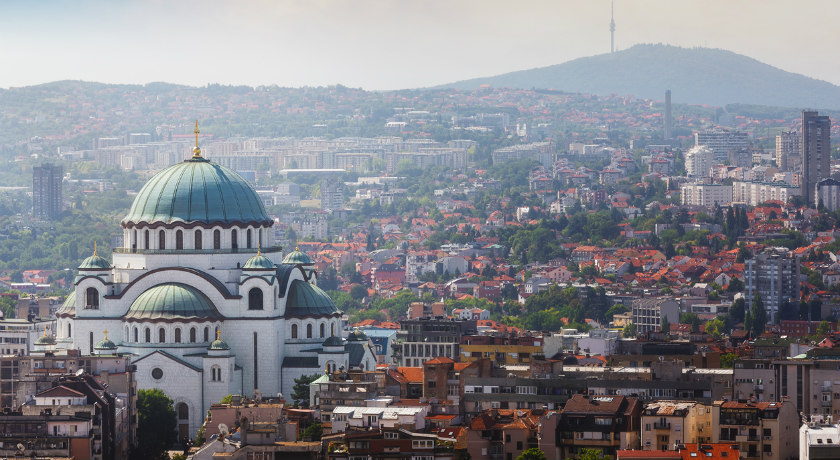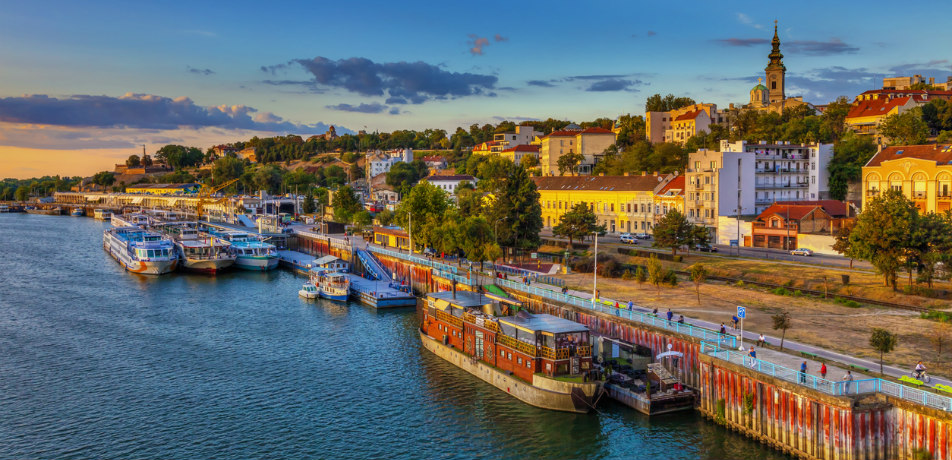The Danube, Europe’s second-longest river, flows through 10 countries — from the Black Forest in Germany to the Black Sea in Romania. And while Danube itineraries rank among river cruising’s most popular, the majority of these journeys are along the river’s upper portion with calls on Vienna, Linz, Bratislava, and Budapest. Pretty familiar places, right? But what if you sailed south? You’d encounter Kalocsa, Vukovar, Osijek, Belgrade, Vidin, Russe, and Bucharest. Definitely not household names (with the exception of Belgrade and Bucharest, both capitals of their respective countries, Serbia and Romania).
So why opt for the Lower Danube? We recently sailed on 190-passenger Viking Embla, one of several identical Viking Longships cruising the Danube, on this 10-night “Passage to Eastern Europe” itinerary. And, from the comfort of this modern vessel — with its sleek Scandinavian décor and excellent cuisine (both locally and internationally inspired) — we were able to get to know a bit about countries and cultures in the mostly post-Communist Balkans that are still raw from wounds inflicted until less than 20 years ago. We saw the abandoned Soviet-era factories and ramshackle villages where remaining residents are mostly elderly with meager incomes. But, we were also inspired by a younger generation focused on education in languages and technology. This isn’t a cruise for travelers focused on places of impeccable beauty, although Budapest certainly qualifies. Rather, this itinerary delves into the not always pretty realities of politics, war, ethnic differences, and economic deprivation; seeing this region first-hand is a learning experience.
Here are seven reasons to consider a Lower Danube cruise, as well as important tips to consider before you book.
Why Visit?
The cruise is bookended by two incredible cities, Budapest and Bucharest. Many river cruisers have likely visited Budapest before on Upper Danube itineraries—and the Hungarian capital is definitely worth experiencing again. The city continues to flourish with ongoing renovation to its trove of Gothic, Neo-Gothic, and Art Nouveau landmarks; loads of appealing wine bars; and an expanding culinary scene that’s growing more international and upscale— but is still exceptionally affordable. And gliding past the illuminated Hungarian Parliament at night remains one of the most captivating sights in river cruising. Then, there’s Bucharest. Once you get beyond the rows of Soviet Bloc-era concrete apartment buildings on its outskirts, the Romanian capital reveals its classic beauty, although it’s at least a decade behind Budapest tourism-wise. There is still a grittiness in many neighborhoods, but the wide Parisian-style boulevards, the elaborate buildings of Old Town (especially the Romanian Athenaeum and historic Orthodox churches), the audacious mid-1960s décor of Spring Palace (the former home of executed Romanian dictator Nicolae Ceausescu and his wife Elena), and the massive 3,000-room Palace of the Parliament (the world’s second-largest administrative building after the Pentagon), are all quite compelling.

You’ll experience five intriguing and complex countries. In addition to Hungary and Romania, you’ll also visit Croatia, Serbia, and Bulgaria. These destinations are still emerging from decades of Communist rule and recent regional warfare, which continues to be part of the complex political and geographical reality. And while coastal Croatia (hello, Dubrovnik and Split) may be familiar to anyone who has cruised the Adriatic, eastern Croatia is a bit more under-the-radar. Here, you'll exploring the cities of Vukovar and Osijek, both of which were heavily damaged by the Homeland War in the '90s; however, both feature several restored Baroque and Belle Époque buildings painted in uplifting pastel hues. Neighboring Serbia is home to the former Yugoslavian capital Belgrade, which is one of the oldest cities in Europe with an Old Town. (Plus, it's easy to explore on foot.) Bulgaria has a scenic landscape and folkloric charm, and even the weary port city of Vidin has hidden architectural gems (not to mention Bulgaria’s best-preserved medieval castle, Baba Vida Fortress) and after several more years of restoration it should be more than camera-ready.
You’ll visit the world’s other notoriously unfinished church. Barcelona’s famous La Sagrada Familia has some competition: Church of St. Sava in Belgrade. Construction on this Serbian Orthodox temple — which features white marble-and-granite facade and symmetrical domes — began in 1935 but was interrupted by World War II, the rise of Communism, and regional war in the 1990s. The exterior is now complete, but the only interior space that’s finished is the subterranean crypt. Don’t let that scare you, though: this arched, gilded, and frescoed space is amazing, and it's one of the largest Eastern Orthodox churches in the world.
Sailing through the Iron Gates is a scenic wonder. Between Serbia and Bulgaria, the Danube narrows into a majestic gorge with the Balkan Mountains to the south and the Carpathian Mountains to the north. An afternoon of scenic sailing here —especially on a warm sunny afternoon — provides a relaxing break from touring by bus and foot. Two sights not to miss: Roman-era Trajan’s Tablet on the Serbian side and the ancient-looking but quite modern rock sculpture of Dacian King Decebalus on the Romanian side.

The Belogradchik Rocks & Fortress is a worthwhile climb. Enjoy something totally unexpected? Check out the red-hued rock formations rising from the rolling green landscape of central Bulgaria. Located near the town of Belogradchik, the rocks are home to a fortress originally built by the Romans and later reconstructed by the Ottomans in the 14th century. If you’re up for some rigorous exercise, you can climb several hundred stone and wood steps to the top for a panoramic view.
You’ll discover wines from places that have been making it for millennia. All five countries make surprisingly delicious and affordable wines, and they've been doing so for thousands of years. Prepare to try some familiar and unfamiliar varietals (Merlot and Mavrud in Bulgaria, for instance) and learn to say cheers in Hungarian (egészségedre), Croatian (zivjeli), Serbian (ziveli), Bulgarian (nazdráve), and Romanian (noroc).
You can add on a pre- or post-cruise visit to Transylvania. Whether you start or end your cruise in Bucharest, don’t miss a visit to Transylvania, which is about a three hours away by car.If you enjoy touring by bus with a guide, you can likely book an add-on through the cruise line. But if you want a less-rigid option, check out the two-day “Dracula’s Castle, Peles Castle and Sighisoara: Medieval Trip” by One Excellence Tours, which offers affordably priced, small group van tours (6 to 8 passengers) with a driver/guide plus plenty of free time. You’ll visit the region’s highlights — Peles Castle, Bran Castle, Brasov and Sibiu — with an overnight in Sighisoara, the birthplace of Vlad the Impaler (who served as the inspiration for Dracula).

What You Need to Know
You will be on buses a lot. With the exception of Budapest and Belgrade, where you can walk off the ship and sightsee the historical centers on your own, most points of interest in all other ports require transport by tour bus. Some smaller towns can be explored independently on foot, but there aren’t major sights to enjoy.
Shopping opportunities are limited. If you love to shop for trinkets and local crafts, you’re likely to be disappointed. There really isn’t very much to buy, with the exception of items from Budapest’s Central Market Hall or Hungarian Herendi porcelain. Your best bet: the charming Bulgarian town of Veliko Tarnovo, where a pedestrian-only artisan’s row (Samovodska Charsia) is lined with shops selling local handicrafts.
Depending on the water level, ramps to shore can be very steep. The Danube, like other rivers in Europe where above-normal summer temperatures have caused low water levels over the past few years, is not always friendly to travelers with limited mobility. In some ports, the ramp leading from the ship to shore is placed at a very steep angle, making it very difficult for passengers who rely on canes or walkers to navigate. However, most ships have wheelchairs onboard, and staff can also be of assistance.

It can be very hot from July to September. Sightseeing by foot in Budapest, Belgrade, and Bucharest and visiting the Belogradchik Rocks and Fortress during the heat of summer can be physically exhausting. Consider cruising in April, May, or October for more temperate weather.
If you don’t eat meat or dairy, announce your dietary restrictions in advance. Culinary preferences in the Balkans veer heavily carnivorous — pork and beef are popular —with potatoes, fried cheese, and stewed vegetables as side dishes. So if you are vegetarian, vegan or pescatarian, meals off the ship can be a challenge; if lunch is part of your tour, let your guide know your dietary requirements in advance.
Most Lower Danube itineraries visit similar places, but your 2020 cruise line options vary. Viking River Cruises is the largest operator on the Lower Danube. The cruise line has twice-weekly, 10-night “Passage to Eastern Europe” sailings (which is actually a seven-night cruise plus a two-night pre-cruise hotel stay and a one-night, post-cruise hotel stay) from March to November (from $3,399 per person). Alternatively, Avalon Waterways offers an 8-night Balkan Discovery itinerary from April to October (from $3,319 per person). Scenic offers a 7-night “Black Sea Explorer” sailing in April, May, and October (from $4,945 per person). Tauck’s itinerary is the 12-night “Budapest to the Black Sea,” available in July (from $5,990 per person). AmaWaterways offers 7-night “Gems of Southeast Europe” sailings from March to November (from $2,799 per person). Lastly, Uniworld has the 9-night “Highlights of Eastern Europe” itinerary available from April to September (from $4,499 per person).
